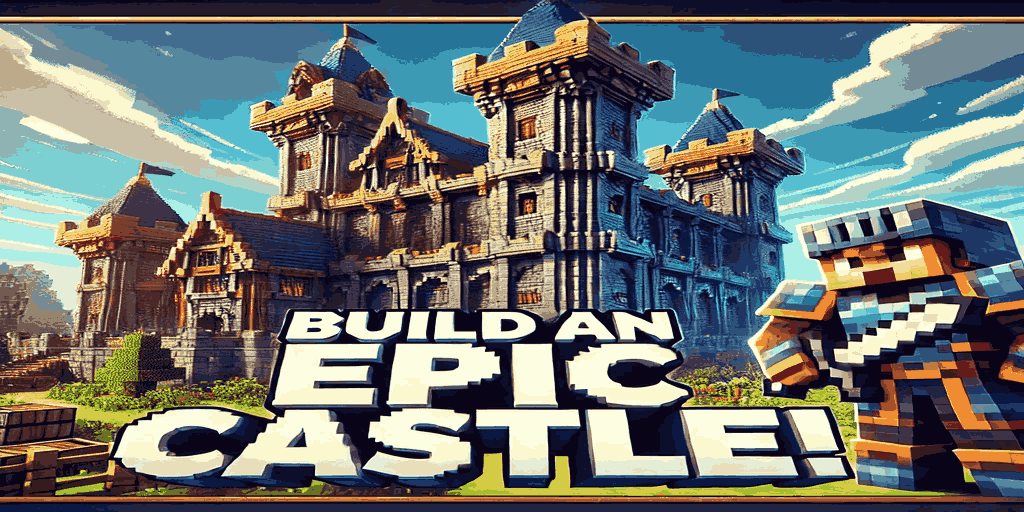Building a castle in Infinity Craft, the popular Minecraft-inspired sandbox game, is a rewarding project that showcases your creativity and strategic skills. Castles are not only fun to design but also offer practical benefits such as protection, storage, and a base for all your adventures. This guide will take you through the essential steps for planning, designing, and constructing a castle in Infinity Craft, making the process both enjoyable and efficient.
Step 1: Plan Your Castle Design
Before diving into construction, planning is crucial. Start by envisioning the type and style of castle you want to create. Here are some considerations:
- Castle Size: Determine the size of your castle based on the time and resources you have. A small fortress with a few rooms is easier to build, while a sprawling medieval stronghold requires more time and materials.
- Architectural Style: Choose a style that aligns with your vision. Common styles include:
- Medieval Fortress: Thick stone walls, moats, and towers.
- Fantasy Castle: A more whimsical look with spires and decorative features.
- Military Stronghold: Simple and heavily fortified for defense.
- Location: Select an ideal location with natural defense advantages, such as on a hilltop or surrounded by water. Additionally, look for flat terrain or make any necessary adjustments to prepare the ground for building.
Step 2: Gather Resources
Once you’ve planned your castle, start gathering resources. Here’s a list of materials typically needed for a castle:
- Stone: Essential for walls, floors, and towers.
- Wood: Used for roofing, interiors, doors, and decorative elements.
- Iron and Steel: Reinforces doors, gates, and other fortified areas.
- Glass: For windows and lookout points.
- Decorative Blocks: Blocks like colored wool, terracotta, and stone bricks add visual interest.
- Utility Items: Torches, lanterns, and doors are necessary for a livable, functional space.
To speed up resource collection, consider using tools with enchantments to maximize mining efficiency, and ensure you have adequate storage to keep your materials organized.

Step 3: Layout and Foundation
A good layout is key to building a functional and aesthetically pleasing castle. Follow these steps for a solid foundation:
- Draw an Outline: Mark the perimeter of your castle. Use blocks like dirt or temporary markers to create a rough outline, defining where walls, gates, and towers will go.
- Divide Into Sections: Break the area into key sections, such as:
- Main Gate: The primary entrance, which may include a portcullis (a gate that can be lowered) for extra security.
- Courtyard: An open area where resources can be stored, or workshops can be built.
- Towers: Strategic points for defense and observation. Common placements include the four corners or along the walls.
- Living Quarters and Storage: Separate areas for sleeping quarters, crafting, and storage.
- Establish the Foundation: Begin laying the base of your walls with sturdy blocks like stone or cobblestone. Make sure this foundation is level and evenly distributed, as it will support the rest of the structure.
Step 4: Build the Castle Walls
Walls form the primary line of defense for your castle, so focus on making them tall and sturdy. Here’s how to proceed:
- Height and Thickness: Aim for walls that are at least 3-5 blocks thick for added durability. A height of 8-12 blocks will create an imposing look while offering excellent defense.
- Add Details: Use a mix of stone bricks, cobblestone, and slabs to break up the monotony and add texture. You can also integrate decorative elements like banners or patterned blocks.
- Build Battlements: For a realistic castle look, add battlements or crenellations along the top of the walls. This provides a safe place to defend your castle and shoot from during attacks.
- Gates and Entrances: Your castle needs a secure entrance, typically a large gate. Reinforce it with iron doors, and consider adding a drawbridge or portcullis mechanism for added security.
Step 5: Construct Towers and Watchtowers
Towers are essential components for both aesthetics and defense. Here’s a guide to building effective towers:
- Placement: Place towers at the corners of your walls and consider additional ones along the perimeter. They should offer a clear vantage point over the surrounding land.
- Shape and Size: Most towers are circular or square-shaped. Build them taller than the walls for a clear view and add extra height for a more impressive appearance.
- Interior: Inside each tower, create staircases or ladders for easy access to different levels. Equip the top floors with archery stations or lookout posts.
- Roofing and Details: Add peaked roofs or parapets to finish your towers. Decorative touches like flags or torches can enhance the aesthetic and make your castle stand out.
Step 6: Design the Interior
Now that the outer structure is complete, turn your attention to the interior. Here are key areas to focus on:
- Living Quarters: Design cozy rooms with beds, chests, and decorations. Add windows for natural light and personal touches like carpets or paintings.
- Storage Areas: A castle requires ample storage for resources, weapons, and equipment. Designate rooms with chests and item frames for organized storage.
- Workshops: Set up crafting tables, furnaces, and anvils in a workshop area. This space will be useful for preparing resources and making repairs.
- Decorative Touches: Add carpets, tapestries, and furnishings to give your castle a lived-in look. Use candles, torches, or lanterns to keep the interior well-lit.
Step 7: Build the Castle Courtyard
The courtyard is a central open space that can serve various purposes. Here are some ideas:
- Gardens and Fountains: Create a small garden area with trees, flowers, and maybe a decorative fountain for a tranquil touch.
- Training Grounds: Set up a combat training area with target dummies and open space for practicing.
- Animal Pens: Use the courtyard to house livestock, like horses or chickens, which can be useful for farming and transportation.
Step 8: Add Final Details and Defensive Features
To make your castle secure and aesthetically pleasing, consider the following enhancements:
- Moat: Dig a moat around the castle and fill it with water or lava. This adds a natural defense barrier, deterring mobs and attackers.
- Drawbridge: Add a drawbridge to the main entrance for easy access to the castle. You can build a functioning drawbridge with redstone if available in your version of Infinity Craft.
- Watch Posts and Archery Stations: Equip walls and towers with designated shooting posts for protection.
- Lighting: Proper lighting, both inside and outside, deters mobs from spawning and adds to the ambiance of the castle at night.
Step 9: Enhance with Redstone Mechanics (If Available)
If Infinity Craft allows for redstone or similar mechanics, consider adding these functional elements:
- Automated Doors and Traps: Secure your castle with pressure plates or hidden traps that can be triggered when intruders approach.
- Secret Passageways: Redstone mechanisms can create hidden doors or tunnels, providing emergency escape routes or secret rooms for storage.
Step 10: Maintain and Customize
Once your castle is built, remember to maintain it. Make repairs after attacks, replace broken blocks, and keep it stocked with supplies. Periodically, you may want to add new rooms, upgrade sections, or even expand the castle grounds as you gather more resources.
Conclusion
Building a castle in Infinity Craft is a fantastic way to unleash your creativity and establish a stronghold. By planning your design, gathering resources, and building step-by-step, you’ll end up with a castle that’s not only functional but also a stunning visual landmark. Take your time, enjoy the process, and adapt these tips to suit your style and gameplay needs.
Read Also
- Has MrBeast Won Any Awards for His Donations?
- How to Stop Pop Up in Shein
- 30 Best Manga18fx Alternatives In 2024
- What Is the Red Circle Paper Plane Icon on Pinterest?
- LinkedIn for eCommerce: A Comprehensive Guide
